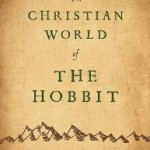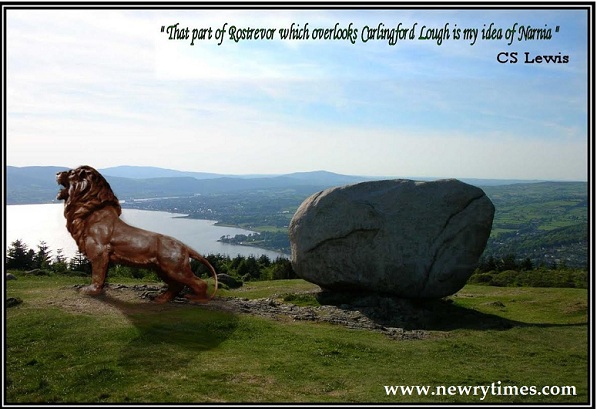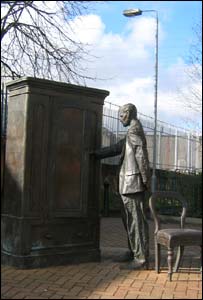
 Hey, everybody, welcome back to Through a New Wardrobe: The NarniaFans.com Interviews. We have an exciting two-part interview series with our long-time friend, Devin Brown, author of the Inside Narnia Series. We will be discussing his brand new book, The Christian World of The Hobbit.
Hey, everybody, welcome back to Through a New Wardrobe: The NarniaFans.com Interviews. We have an exciting two-part interview series with our long-time friend, Devin Brown, author of the Inside Narnia Series. We will be discussing his brand new book, The Christian World of The Hobbit.
Last time, we spoke with Professor Devin Brown, we talked about his interest in CS Lewis and JRR Tolkien, and talked a bit about the classes he teaches on Lewis and Tolkien at Asbury College. Now, we discuss a few details about his new book The Christian World of The Hobbit.
NarniaFans: In what ways is The Christian World of The Hobbit different from the Inside Narnia series? In what ways is it similar?
Devin Brown: People who have read my three books from the Inside Narnia series know that they all start with chapter one and go through the entire book—The Lion, the Witch and the Wardrobe; Prince Caspian; or The Voyage of the Dawn Treader—from start to finish, looking at any aspect that seems worth exploring.
In The Christian World of The Hobbit, I take a thematic approach. I first discuss Tolkien’s faith background, then I look at the Providence in the book, then the purpose, and finally the moral landscape.
No matter how you organize it, I am still doing literary analysis—which I know is not everyone’s cup of tea. Hopefully, I do it is a way that both interesting and fair.
NF: I’ll admit as an English major, I did find some literary analysis that I read for class to be about as much fun as reading a telephone book. Your books however, are actually fun! What’s your secret?
DB: Lewis and Tolkien both say that they tried to write the kind of book they would like themselves. I suppose I would say the same about what I try to do. I have read some of those phone books pretending to be literary analysis!
NF: In what ways is The Christian World of The Hobbit different from other books on Tolkien, in particular those by Christians?
DB: I am not going to speak ill of any specific books, but despite Tolkien’s insistence that his works are not allegories, you can still find authors who want to argue that Galadriel is the Virgin Mary and that the lembas the Elves give the fellowship is the Eucharist. I don’t do that sort of thing. I try to argue that Tolkien’s works are “essentially” or fundamentally Christian, which is not difficult to do since Tolkien himself said they were.
NF: And yet the funny thing is I didn’t see many of these books (looking at the symbolism in LOTR) in print until the release of the first part of the Lord of the Rings film saga. Prior to this point, most Christians didn’t even regard LOTR as a Christian work. Why do you think that view changed over the years?
DB: Maybe the reason that there was little awareness of the Christian worldview that permeates Middle-earth was because there had been relatively little published about it. There was relatively little published about it because until the films came along, there was relatively little market for secondary materials about Tolkien. I always forget that just because I am interested in any new book about Lewis or Tolkien that comes out, not everyone shares my interest.
NF: Now for many readers of Tolkien’s mythology, they can easily see symbolism in The Lord of the Rings, but not so much in The Hobbit. Why do you think this is?
DB: Well, being a literature teacher, I would first say that what people are seeing are not literary symbols but something better called Christian parallels or echoes. Gandalf is a Christ-figure; he is not a symbol of Christ. There are parallels between Frodo’s self-sacrifice to save Middle-earth and the sacrifice Jesus makes. But Mount Doom is not meant to symbolize the Hill of Calvary.
In writing my book, I really came to see that while Bilbo’s quest starts in The Hobbit, it does not end there.
Tolkien’s story of Bilbo Baggins, which he initially began as a bedtime story for his children, was a tale that grew in the telling. By the time that Tolkien wrote of Bilbo’s final journey with Frodo over the sea to be healed, he had a richer, deeper, more meaningful conception of what Bilbo’s quest had been about. After The Lord of the Rings was published, Tolkien went back and made changes to The Hobbit to make Bilbo’s story, which started in the first chapter of The Hobbit and ends in the final chapter of The Return of the King, more seamless, more all of one piece.
On the last page of The Hobbit, Gandalf says to Bilbo, “You don’t really suppose, do you, that all your adventures and escapes were managed by mere luck, just for your sole benefit?” In The Lord of the Rings, Tolkien shows us a little more who or what has been behind the scenes in Middle-earth, managing things.
NF: One thing I enjoyed about your book is how you compare and contrast Tolkien’s work with C. S. Lewis. How important do you think looking at their works together is to understanding both men, and their contribution to fantasy literature?
DB: While most people know that Tolkien did not approve of the way Lewis mixed mythologies in The Chronicles of Narnia—including Father Christmas with Nordic dwarves and fauns from Greece—they did share a deep common ground. They shared a similar moral landscape. For example, they both show how help often comes in form that don’t look very much like help at the time. Their characters find purpose and meaning by looking beyond their own lives.
NF: I loved the illustrations in this book! Who drew them?
DB: They were done by a great young artist named Gary Morgan. People have been saying very good things about them. Anyone interested who doesn’t have the book can go to www.gmorganillustrations.com and click on Book Illustrations to see them. They can also go find my book on Amazon and use the Look Inside feature. I particularly like the one of Bard shooting Smaug and the one of Beorn.
NF: Why include illustrations this time around and not in the Inside Narnia series?
DB: The illustrations were the idea of Lil Copan, my editor at Abingdon. Here’s how little I know about book design: initially I thought they might not work so great with my text. Now everyone who has seen them makes a point of telling me how much they add to the book. That’s why you have an editor who makes these kinds of decisions.
NF: The Cover art looks exactly like it was taken from one of Tolkien’s maps. Is this the case?
DB: The cover, which everyone in the world seems to love, was done by Emily Weigel. I think the idea is that it is supposed to look as much like one of Tolkien’s maps as it possibly can without looking so identical that the Tolkien Estate wants to sue for copyright infringement.
Emily sent us three different cover designs to pick from. One was a cover that looked like The Shire. One had Smaug on it. And this one looks like the yellowed map that Thorin’s father gave to Gandalf before perishing in the dungeons of the Necromancer. All three covers were great, but the one with the map was the best of the three.
NF: What do you hope readers take away from this book?
DB: I know that it seems like a rather grandiose goal, but I hope to impact the way that people will read The Hobbit from now on. If you read my book, I really think the way you look at Tolkien’s fiction will be changed, forever changed I might say.
On a less grand level, I hope that readers will come to see how Tolkien’s faith impacted his fiction.
Most of all, I hope that I help people to understand and to enjoy Tolkien’s beloved classic more than they did before. I think the two go together—the better you understand a work, the more you will enjoy it.
NF: Might we see more books on Tolkien authored by you?
DB: With Hobbit films taking us into 2014, you never know. That said, my next book is going to be a new biography of Lewis that will be published by Brazos Press in summer 2013 to mark the 50th anniversary of Lewis’s death. I have already written a good bit of it, and since no one has read it yet, you’ll just have to take my word that it’s going to be worth taking a look at. It is tentatively titled A Life Observed; A Spiritual Biography of C. S. Lewis and should be available for pre-order on Amazon around Christmas.
NF: Thank you so much for your time.
DB: It’s been a pleasure. Thank you.
Look for Devin Brown’s new book, The Christian World of The Hobbit. availble in stores this month. And be back later this week for our review of this brand new book.
View the trailer bellow:




Hmm, interesting. I wonder what the new Lewis bio will be able to tell us that hasn’t been covered by AN Wilson or by Hooper and Lancelyn Green…
Given that the Narnia Fans website is now doing reviews of other literature than the Narnia films I have a suggestion. What about doing reviews of other films which have a Christian theme to them? This will be something useful to do until the next Narnia film comes along. I notice from the Movie Times website at http://www.the-movie-times.com that the big ticket sellers in 2012 are the Marvel Comics superhero stuff. This is not exactly my thing and is not going to persuade me to buy cinema tickets.